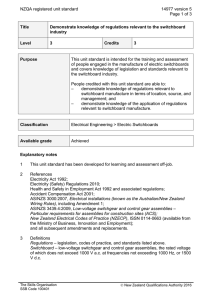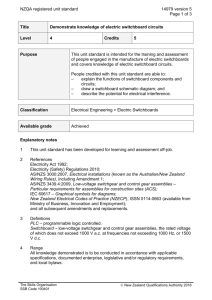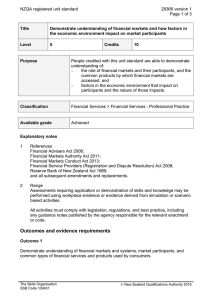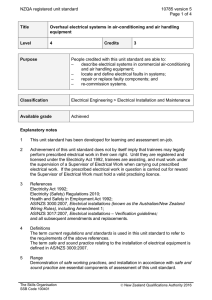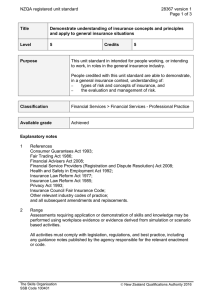NZQA registered unit standard 14978 version 5 Page 1 of 4
advertisement
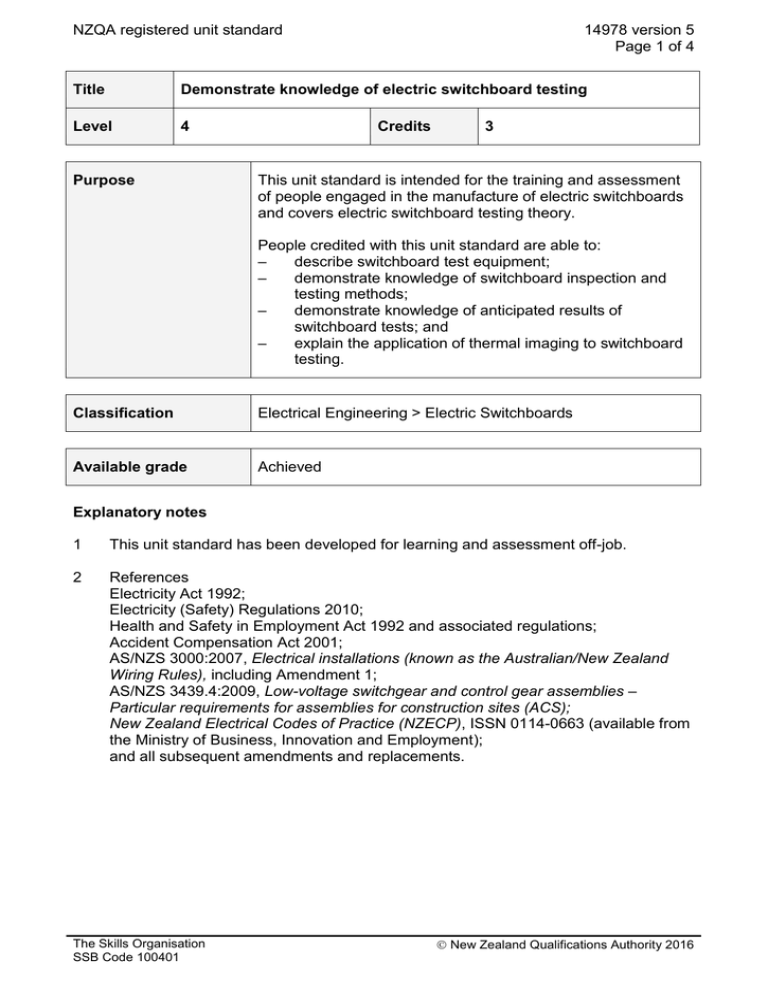
NZQA registered unit standard 14978 version 5 Page 1 of 4 Title Demonstrate knowledge of electric switchboard testing Level 4 Purpose Credits 3 This unit standard is intended for the training and assessment of people engaged in the manufacture of electric switchboards and covers electric switchboard testing theory. People credited with this unit standard are able to: – describe switchboard test equipment; – demonstrate knowledge of switchboard inspection and testing methods; – demonstrate knowledge of anticipated results of switchboard tests; and – explain the application of thermal imaging to switchboard testing. Classification Electrical Engineering > Electric Switchboards Available grade Achieved Explanatory notes 1 This unit standard has been developed for learning and assessment off-job. 2 References Electricity Act 1992; Electricity (Safety) Regulations 2010; Health and Safety in Employment Act 1992 and associated regulations; Accident Compensation Act 2001; AS/NZS 3000:2007, Electrical installations (known as the Australian/New Zealand Wiring Rules), including Amendment 1; AS/NZS 3439.4:2009, Low-voltage switchgear and control gear assemblies – Particular requirements for assemblies for construction sites (ACS); New Zealand Electrical Codes of Practice (NZECP), ISSN 0114-0663 (available from the Ministry of Business, Innovation and Employment); and all subsequent amendments and replacements. The Skills Organisation SSB Code 100401 New Zealand Qualifications Authority 2016 NZQA registered unit standard 14978 version 5 Page 2 of 4 3 Definitions CT – current transformers. HV – high voltage. Industry practice – practice used and recommended by organisations involved in the electrotechnology industry. Switchboard – low-voltage switchgear and control gear assemblies, the rated voltage of which does not exceed 1000 V a.c. at frequencies not exceeding 1000 Hz, or 1500 V d.c. VT – voltage transformers. 4 Range All knowledge demonstrated is to be conducted in accordance with applicable specifications, documented enterprise, legislative and/or regulatory requirements, and local bylaws. Outcomes and evidence requirements Outcome 1 Describe switchboard test equipment. Range test equipment includes – insulation tester, HV tester, current injection test set, ductor set, CT, polarity test set. Evidence of five instruments is required. Evidence requirements 1.1 The purpose of each piece of equipment is described. 1.2 The method of use of each piece of equipment is explained in relation to specific test requirements. 1.3 Calibration needs and safety precautions appropriate to the use of each piece of equipment is described. Outcome 2 Demonstrate knowledge of switchboard inspection and testing methods. Evidence requirements 2.1 A typical sequence of inspections and tests, which provides for efficiency and safety, is described. Range inspections – layout, busbars; tests – CT, VT, wiring, insulation, potential, functional. 2.2 CT tests, polarity testing, and current injection testing are described in terms of procedure and instruments used. 2.3 The test voltages to be used for common nominal switchboard voltages are stated. The Skills Organisation SSB Code 100401 New Zealand Qualifications Authority 2016 NZQA registered unit standard 14978 version 5 Page 3 of 4 2.4 One method of systematically testing the operating voltages of all circuits in the switchboard is explained in accordance with industry practice. 2.5 One method of calibrating and testing circuit breakers is described in accordance with industry practice. 2.6 The safe working clearances for high-voltage testing and operational testing are stated in accordance with industry practice. Outcome 3 Demonstrate knowledge of anticipated results of switchboard tests. Evidence requirements 3.1 Typical tolerances for test results are stated. 3.2 Flashover and/or puncture occurring during insulation and HV tests are explained. 3.3 Reasons for acceptable pass/fail criteria for insulation tests carried out at the test voltages defined in AS/NZS 3439.1:2002 Table 10 are stated. 3.4 Primary VT ratio and its relevance to test results are described. Outcome 4 Explain the application of thermal imaging to switchboard testing. Evidence requirements 4.1 The term thermal imaging is explained with reference to the operation and use of thermal imaging equipment. 4.2 Thermal imaging is explained in terms of how it detects hot spots on the switchboard. 4.3 Types of fault that may be detected with thermal imaging technology is explained. Planned review date 31 December 2014 Status information and last date for assessment for superseded versions Process Version Date Last Date for Assessment Registration 1 31 August 1998 31 December 2013 Revision 2 12 March 2002 31 December 2013 Review 3 20 March 2008 N/A The Skills Organisation SSB Code 100401 New Zealand Qualifications Authority 2016 NZQA registered unit standard 14978 version 5 Page 4 of 4 Process Version Date Last Date for Assessment Rollover and Revision 4 15 March 2012 N/A Revision 5 15 January 2014 N/A Consent and Moderation Requirements (CMR) reference 0003 This CMR can be accessed at http://www.nzqa.govt.nz/framework/search/index.do. Please note Providers must be granted consent to assess against standards (accredited) by NZQA, before they can report credits from assessment against unit standards or deliver courses of study leading to that assessment. Industry Training Organisations must be granted consent to assess against standards by NZQA before they can register credits from assessment against unit standards. Providers and Industry Training Organisations, which have been granted consent and which are assessing against unit standards must engage with the moderation system that applies to those standards. Requirements for consent to assess and an outline of the moderation system that applies to this standard are outlined in the Consent and Moderation Requirements (CMR). The CMR also includes useful information about special requirements for organisations wishing to develop education and training programmes, such as minimum qualifications for tutors and assessors, and special resource requirements. Comments on this unit standard Please contact The Skills Organisation reviewcomments@skills.org.nz if you wish to suggest changes to the content of this unit standard. The Skills Organisation SSB Code 100401 New Zealand Qualifications Authority 2016
